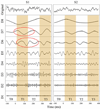Sensory gating endophenotype based on its neural oscillatory pattern and heritability estimate
- PMID: 18762587
- PMCID: PMC2774756
- DOI: 10.1001/archpsyc.65.9.1008
Sensory gating endophenotype based on its neural oscillatory pattern and heritability estimate
Abstract
Context: The auditory sensory gating deficit has been considered a leading endophenotype in schizophrenia. However, the commonly used index of sensory gating, P50, has low heritability in families of people with schizophrenia, raising questions about its utility in genetic studies. We hypothesized that the sensory gating deficit may occur in a specific neuronal oscillatory frequency that reflects the underlying biological process of sensory gating. Frequency-specific sensory gating may be less complex than the P50 response, and therefore closer to the direct genetic effects, and thus a more valid endophenotype.
Objectives: To compare the gating of frequency-specific oscillatory responses with the gating of P50 and to compare their heritabilities.
Design: We explored single trial-based oscillatory gating responses in people with schizophrenia, their relatives, and control participants from the community.
Setting: Outpatient clinics.
Participants: Persons with schizophrenia (n = 102), their first-degree relatives (n = 74), and control participants from the community (n = 70).
Main outcome measures: Gating of frequency-specific oscillatory responses, gating of the P50 wave, and their heritability estimates.
Results: Gating of the theta-alpha-band responses of the control participants were significantly different from those with schizophrenia (P < .001) and their first-degree relatives (P = .04 to .009). The heritability of theta-alpha-band gating was estimated to be between 0.49 and 0.83 and was at least 4-fold higher than the P50 heritability estimate.
Conclusions: Gating of the theta-alpha-frequency oscillatory signal in the paired-click paradigm is more strongly associated with schizophrenia and has significantly higher heritability compared with the traditional P50 gating. This measure may be better suited for genetic studies of the gating deficit in schizophrenia.
Figures




Comment in
-
"Familiality" or heritability.Arch Gen Psychiatry. 2009 Apr;66(4):452-3. doi: 10.1001/archgenpsychiatry.2009.14. Arch Gen Psychiatry. 2009. PMID: 19349315 Free PMC article. No abstract available.
Similar articles
-
P50 sensory gating in multiplex schizophrenia families from a Pacific island isolate.Am J Psychiatry. 2002 Dec;159(12):2007-12. doi: 10.1176/appi.ajp.159.12.2007. Am J Psychiatry. 2002. PMID: 12450949
-
A shared low-frequency oscillatory rhythm abnormality in resting and sensory gating in schizophrenia.Clin Neurophysiol. 2012 Feb;123(2):285-92. doi: 10.1016/j.clinph.2011.07.025. Epub 2011 Sep 8. Clin Neurophysiol. 2012. PMID: 21862398 Free PMC article. Clinical Trial.
-
Sensory gating event-related potentials and oscillations in schizophrenia patients and their unaffected relatives.Schizophr Bull. 2011 Nov;37(6):1187-99. doi: 10.1093/schbul/sbq027. Epub 2010 Apr 2. Schizophr Bull. 2011. PMID: 20363872 Free PMC article.
-
P50 sensory gating ratios in schizophrenics and controls: a review and data analysis.Psychiatry Res. 2008 Mar 15;158(2):226-47. doi: 10.1016/j.psychres.2007.02.009. Epub 2008 Jan 9. Psychiatry Res. 2008. PMID: 18187207 Review.
-
[P50 sensory gating disorders of auditory evoked potentials (AEP) in persons with schizophrenia].Psychiatr Pol. 2004 Sep-Oct;38(5):833-45. Psychiatr Pol. 2004. PMID: 15523930 Review. Polish.
Cited by
-
Electrophysiological intermediate biomarkers for oxidative stress in schizophrenia.Clin Neurophysiol. 2013 Nov;124(11):2209-15. doi: 10.1016/j.clinph.2013.05.021. Epub 2013 Jun 30. Clin Neurophysiol. 2013. PMID: 23823132 Free PMC article. Clinical Trial.
-
High-frequency neural oscillations and visual processing deficits in schizophrenia.Front Psychol. 2013 Oct 9;4:621. doi: 10.3389/fpsyg.2013.00621. Front Psychol. 2013. PMID: 24130535 Free PMC article. Review.
-
Synaptic plasticity, neural circuits, and the emerging role of altered short-term information processing in schizophrenia.Front Synaptic Neurosci. 2014 Nov 25;6:28. doi: 10.3389/fnsyn.2014.00028. eCollection 2014. Front Synaptic Neurosci. 2014. PMID: 25505409 Free PMC article. Review.
-
Mismatch negativity and low frequency oscillations in schizophrenia families.Clin Neurophysiol. 2012 Oct;123(10):1980-8. doi: 10.1016/j.clinph.2012.03.011. Epub 2012 Apr 25. Clin Neurophysiol. 2012. PMID: 22541739 Free PMC article.
-
Akting up in the GABA hypothesis of schizophrenia: Akt1 deficiency modulates GABAergic functions and hippocampus-dependent functions.Sci Rep. 2016 Sep 12;6:33095. doi: 10.1038/srep33095. Sci Rep. 2016. PMID: 27615800 Free PMC article.
References
-
- Freedman R, Adler LE, Gerhardt GA, Waldo M, Baker N, Rose GM, Drebing C, Nagamoto H, Bickford-Wimer P, Franks R. Neurobiological studies of sensory gating in schizophrenia. Schizophr Bull. 1987;13:669–678. - PubMed
-
- Braff DL, Geyer MA. Sensorimotor gating and schizophrenia. Human and animal model studies. Arch Gen Psychiatry. 1990;47:181–188. - PubMed
-
- Bramon E, Rabe-Hesketh S, Sham P, Murray RM, Frangou S. Meta-analysis of the P300 and P50 waveforms in schizophrenia. Schizophr Res. 2004;70:315–329. - PubMed
-
- de Wilde OM, Bour LJ, Dingemans PM, Koelman JH, Linszen DH. A meta-analysis of P50 studies in patients with schizophrenia and relatives: differences in methodology between research groups. Schizophr Res. 2007;97:137–151. - PubMed
-
- Siegel C, Waldo M, Mizner G, Adler LE, Freedman R. Deficits in sensory gating in schizophrenic patients and their relatives. Evidence obtained with auditory evoked responses. Arch Gen Psychiatry. 1984;41:607–612. - PubMed
Publication types
MeSH terms
Grants and funding
- M01-RR16500/RR/NCRR NIH HHS/United States
- K23 MH070644/MH/NIMH NIH HHS/United States
- R01 MH067014/MH/NIMH NIH HHS/United States
- MH67014/MH/NIMH NIH HHS/United States
- R03 MH068282/MH/NIMH NIH HHS/United States
- P30 MH068580/MH/NIMH NIH HHS/United States
- MH70644/MH/NIMH NIH HHS/United States
- MH77852/MH/NIMH NIH HHS/United States
- M01 RR016500/RR/NCRR NIH HHS/United States
- R01 MH049826/MH/NIMH NIH HHS/United States
- MH68580/MH/NIMH NIH HHS/United States
- MH68282/MH/NIMH NIH HHS/United States
- R21 MH079172/MH/NIMH NIH HHS/United States
- MH79172/MH/NIMH NIH HHS/United States
- R01 MH077852/MH/NIMH NIH HHS/United States
- R01 MH085646/MH/NIMH NIH HHS/United States
- MH49826/MH/NIMH NIH HHS/United States
LinkOut - more resources
Full Text Sources
Other Literature Sources
Medical
Research Materials

